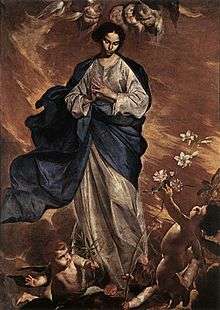Bernardo Cavallino

Bernardo Cavallino (1616–1656) was an Italian painter and draughtsman active in Naples.
Biography
Born in Naples, he is thought to have died during the plague epidemic in 1656. Little is known about his background or training. Of eighty attributed paintings, less than ten are signed. He worked through private dealers and collectors whose records are no longer available.

It is said that he trained with Massimo Stanzione, befriended the painter Andrea Vaccaro, and was influenced by Anthony van Dyck, but his paintings could also be described as equidistant from Caravaggio and Bartolomé Esteban Murillo in styles; tenebrism enveloped with a theatrical sweetness, a posed ecstasy and feeling characteristic of the high Roman baroque statuary. He is known to have worked in Neapolitan circles strongly influenced by Stanzione, which included Antonio de Bellis, Artemisia Gentileschi, Francesco Francanzano, Agostino Beltrano and Francesco Guarino.
Style
Most of Cavallino's works are on the scale of cabinet paintings, and he is not known to have executed any large decorations.[1] The art historian Ann Percy describes him as "the most individual and most poetic painter active in Naples during the first half of the 17th century ... uniting a refinement and virtuosity of brushwork with an intensely naturalistic observation of surfaces, and complex and dramatic compositions with an extraordinary brilliance of palette."[1] One of his masterpieces is the billowing proletarian Blessed Virgin at the Brera Gallery in Milan. Passive amid the swirling, muscular putti, this Neapolitan signorina delicately rises from the fog, the updated Catholic baroque equivalent of a Botticelli's Venus. His The Ecstasy of St Cecilia exists both as cartoon (Museo di Capodimonte, Naples)[2] and final copy in the Palazzo Vecchio of Florence. Finally, his Esther and Ahasuerus hangs in the Uffizi Gallery.[3]
Works
- Immaculate Conception (1640), 69 cm x 45 cm, Musée des Beaux-Arts, Caen
- Immaculate Conception (1650), Brera Gallery, Milan
- The Ecstasy of Saint Cecilia, cartoon, Museo di Capodimonte, Naples
- The Ecstasy of Saint Cecilia, final work, Palazzo Vecchio, Florence
- Esther and Ahaseurus, Uffizi Gallery, Florence
- Adoration of the Magi
- Gaius Mucius Scaevola Confronting King Porsenna
- Saint John the Baptist
- Clavicord Player
- Hercules and Omphale
- Adoration of the Pastor
- The Vision of Saint Dominic
- Lot and his Daughters
- Virgin Annunciate (c. 1645-50), 85.5 cm x 70.0 cm, National Gallery of Victoria, Melbourne, Australia
References
- 1 2 Ann Percy. "Cavallino, Bernardo." Grove Art Online. Oxford Art Online. Oxford University Press. Web. 28 October 2016
- ↑ The Ecstasy of St Cecilia (Naples)
- ↑ Esther and Ahaseurus (Uffizi, Florence)
Literature
- De Dominici, Bernardo (1742). Vite dei Pittori, Scultori, ed Architetti Napolitani, Volume III. Stamperia del Ricciardi, Naples; Digitized by Googlebooks from Oxford University copy on February 1, 2007. 5.
- On Seicento Painting in Naples: Some Observations on Bernardo Cavallino, Artemisia Gentileschi and Others, Józef Grabski. (1985) Artibus et Historiae. p. 23-63.
- Stoughton, Michael (1985). "Bernardo Cavallino". Burlington Magazine. pp. 192–194.
External links
 Media related to Bernardo Cavallino at Wikimedia Commons
Media related to Bernardo Cavallino at Wikimedia Commons- Museum biography
- Orazio and Artemisia Gentileschi, a fully digitized exhibition catalog from The Metropolitan Museum of Art Libraries, which contains material on Bernardo Cavallino (see index)